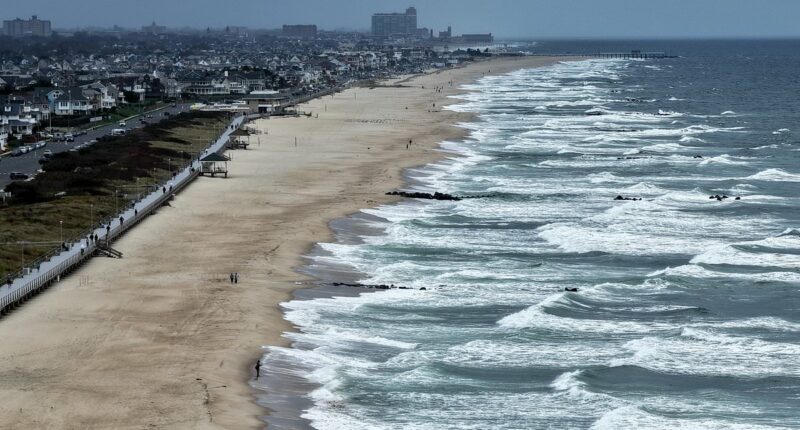Share this @internewscast.com
A State of Emergency has been declared in New Jersey as a storm barrels up the East Coast.
Flooding is predicted to affect the East Coast from South Carolina to New Jersey due to a storm without a name, with high winds forecasted for New York City over the Columbus Day holiday weekend.
‘I urge all New Jerseyans to exercise caution, monitor local weather forecasts and warnings, stay informed on evacuation protocols, and remain off the roads unless absolutely necessary,’ acting New Jersey Governor Tahesha Way emphasized in a statement.
The emergency is effective from 10pm on Saturday. Maryland Governor Wes Moore told residents to stay vigilant along the coast and inland.
Major hubs such as Washington, DC, New York City, and Boston might experience significant travel disruptions, with strong winds likely causing delays and cancellations by Monday morning.
The storm drove sea water into Charleston, South Carolina, again, causing the closure of about three dozen roads as floodwaters rose above ankle height before subsiding.
Friday morning’s high tide reached 8.46 feet which was the 13th highest in more than a century of recorded data in Charleston Harbor.
Tidal flooding also closed roads for a few hours along the Georgia and Florida coasts.

A coastal view shows high tides as New Jersey has declared a state of emergency across all 21 counties due to an impending powerful nor’easter set to bring heavy rain, strong winds, and coastal flooding starting Saturday night.

The nor’easter is anticipated to deliver heavy rain and winds potentially gusting up to 60 mph, with coastal regions possibly facing the most severe effects, including significant coastal flooding.

Storm-force winds and seas of up to 20 feet will be possible on the ocean
The persistent, strong winds from the unnamed nor’easter and unusually high tides, when the moon is closer than usual to the Earth, had forecasters predicting more problems this weekend along the North Carolina Outer Banks.
A series of storms that moved well offshore have destroyed 10 houses in the past month and breached dunes. The pilings of some homes in Buxton were already in the waves before the worst of the storm.
Officials warned highway NC 12 on Hatteras and Ocracoke islands would likely have to close again because of ocean overwash.
The worst conditions will spread north this weekend and into the Columbus Day holiday on Monday as the storm moves up from Florida.
Forecasters warned people on the shores of Delaware and New Jersey to prepare for major coastal flooding with water levels rising to levels not seen in nearly a decade.
The flooding could submerge roads and homes while also causing beach erosion
Gusts over 30 mph have been already measured near the North Carolina coast. Further north, a high wind watch was issued for parts of New York City and Long Island where forecasters warned gusts of up to 60 mph were possible Sunday.
In New York, flooding could reach between 1.5 feet to 2 feet.

As storms continue to thrash the coastal area, at least nine homes have now collapsed into the waters underneath them as 12-foot waves battered the stilts they perched on

Five homes fell in under an hour just after 2pm on Tuesday alone, with another just before midnight

Since 2020, the total number of homes that have fallen victim to the ocean has reached 21 along North Carolina beaches
‘The storm won’t be in a hurry to exit,’ Bill Deger, a senior meteorologist at AccuWeather said.
While the storm isn’t tropical, two other tropical storms are still churning in the Atlantic including Tropical Storm Jerry which dumped heavy rain on the northern Leeward Islands.
There were rescues and one person died after being swept away by water in the French territory of Guadeloupe, officials said.
Searchers found the body of a man inside a car that was swept away by floodwaters after scouring the area by boat, helicopter and two drones. Eight people were rescued on board two boats, the government said.
Two tropical storms were also in the eastern Pacific Ocean. Tropical Storm Priscilla dissipated into a remnant low, but what remained was expected to bring heavy rain from coastal Mexico into the US Southwest through the weekend.
‘Pointe-à-Pitre is badly affected and is struggling to drain this water. Many places are flooded,’ Thierry Devimeux, the island´s government leader, told radio station Guadeloupe La 1ère.

Homes at risk of falling into the ocean are visible as a storm draws ever closer

Debris washes up onto an old swimming pool as a storm approaches on Friday in Buxton, North Carolina

Workers put a piling into the ground to reinforce a home at risk of falling into the ocean as a storm approaches

The lone remains of a home stand in the ocean as a storm approaches in North Carolina

A worker who is reinforcing a home at risk of falling into the ocean looks out toward the waves
Areas of Guadeloupe, Antigua and Barbuda and the Dutch Caribbean territory of Saint Maarten saw as much as 8 inches of rain, closing government offices and schools.
Jerry was centered about 750 miles south of Bermuda and moving north-northwest at 15 mph with maximum sustained winds of 50 mph.
Way up in the northern Atlantic, Subtropical Storm Karen formed far from land, then lost its subtropical characteristics less than 24 hours later, the hurricane center said.
A subtropical storm tends to have a wide zone of strong winds farther from its center compared to a tropical storm, which generates heavier rains, according to the US National Weather Service.
Flood watches were issued for parts of Arizona, California and Nevada.
In the Pacific, tropical storm warnings associated with Tropical Storm Raymond were in effect from Manzanillo to Cabo Corrientes, Mexico; for Las Islas Marias; and for Baja California Sur from Los Barriles to Santa Fe, Mexico.
A couple vehicles had already been swept away by floodwaters in New Mexico late Friday afternoon. In northern Arizona, washes that are normally dry were filled with fast-flowing water.
Raymond was forecast to remain off the southwestern coast of Mexico through Friday before nearing Baja California Sur on Saturday and Sunday.
Raymond was about 145 miles west of Manzanillo. It had maximum sustained winds of 50 mph and was moving northwest at 17 mph, forecasters said.















